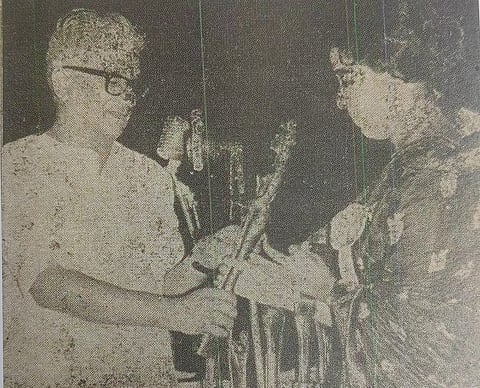

A black and white picture from 1969, shared last week on Facebook, shows Sheela wrapped in a sari, receiving a thin dark statuette from Kerala’s chief minister of the time, C Achutha Menon. The picture is a little grainy but you can make out that the statuette is a sculpted figure of a woman – one among the first 16 film awards ever given away by the state. Sheela was the first to win the State’s Best Actor (Female) award for her unforgettable role in Kalli Chellamma.
After the recent controversy over the form of the award – a slanting woman with one hand raised in a gesture and the other hanging by her side, looking like a dancer in pause – there has been interest in the origins of the design. Some believed it was inspired by the statuette of the National Film Award, established in 1954, of a woman with raised hands holding a strip of film that flows down to cover part of her body. But this is speculation. The man who designed the first Kerala film award statuette – writer, cartoonist, and IAS officer Malayattoor Ramakrishnan – has long passed. So has MRD Dattan, the artist who sculpted Malayattoor’s design.
“I don’t think there would have been any particular instructions given to Malayattoor when he designed the statuette. However, the design underwent changes at least a couple of times,” says Manoj Kumar, former secretary of the Kerala Chalachitra Academy who was earlier additional director at the Public Relations Department. The PRD was in charge of the awards until 1998, the year the Kerala Chalachitra Academy was formed and took over the responsibility.
In 1969, Malayattoor was the secretary of the Industries Department, which was entrusted with the handling of the first film awards. The next year, when it was handed over to the PRD, the design was modified to include a pedestal for the dancing woman to stand on. Manoj remembers how in 1996, the year Malayattoor was the jury chairperson, the writer looked at the statuette and asked him what the big wooden piece below the sculpture was. “That is when I realised that the original design (without the pedestal) was by Malayattoor, who was also an artist,” Manoj says.
Even the pedestal, originally round, evolved into a square shape in 1990 when it was possible to etch words on it like on a metal plate. Another interesting change came at a time when K Karunakaran was the Chief Minister. Owing to an accident, the CM couldn’t handle the statuettes, which weighed 3 kg each. The police asked for lighter statuettes, so the insides were left hollow.
None of these say how the original design came about. Some reports speculated that it might have come from the cover of Malayattoor’s most famous novel Yakshi, later made into a film, which has a woman in a white sari emerging, it would seem, from among trees and red clouds. But the statuette is far from eerie, it is a picture of calm and poise.
If it was ideated from other examples, there were the Filmfare Awards with its statuette, the famous ‘Black Lady’, sloping like the Kerala Award to one side, her hands stretching above her to come together like a dancer’s. Instituted in 1954, she bears more resemblance to the Kerala design than the National Awards sculpture.
Further away, Hollywood’s Academy Awards, launched in 1929, took a masculine form – a knight called Oscar, as it is referred to. Oscar is bronze and plated in gold, weighs 8.5 pounds (heavier than the statuette Karunakaran couldn’t lift) and stands at a height of 13.5 inches. Oscar changed its form too – its base varying in size until 1945, and the bronze replaced by painted plaster for three years during World War II due to a metal shortage. (The Academy later replaced the plaster statuettes with gold plated bronze ones). It is safe to say that Kerala’s version bears no resemblance with her American counterpart, neither in gender nor in texture.